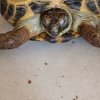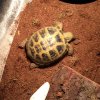KatyshaB
Member
About a month ago, I got a female Russian Tort named Natalie. I got her for breeding purposes, but when I got her she was REALLY tame, she would hang her head out and let you pet it when you picked her up. She is 7 in long, and I believe she is captive bred, they said at the store where I got her that almost all of there animals are captive bred. Now, moving on to my male tort, Bosley. I've had him for four years, he is very shy and I do think he is wild caught because for one, we WILL NOT let you touch his head. And he was a lot more stressed when we first got him. (He is fine now, we took care to make sure he was healthy), now before I begin to ask my question let me tell you I'm not asking the question: "Witch one is better, wild caught or captive bred". I would prefer a captive bred tort (If I knew Bosley was wild caught I wouldn't have gotten him) because of the way they treat wild caught ones in shipping. Anyway, one day I came home and Natalie was upside down pressed against the wall (I will try to post a picture) after taking a picture I quickly flipped her back and wondered what happened. I think Natalie was climbing her log when she flipped and tumbled backwards. Thankfully she was not upside-down long because she hadn't started struggling when I first saw her. Now, Bosley has climbed up onto his log many times and never fallen. He also likes to dig more than Natalie does. So does Bosley have more of an instinct to climb and dig, then Natalie. Because wouldn't Natalie still have the instinct to climb, captive bred or not?




